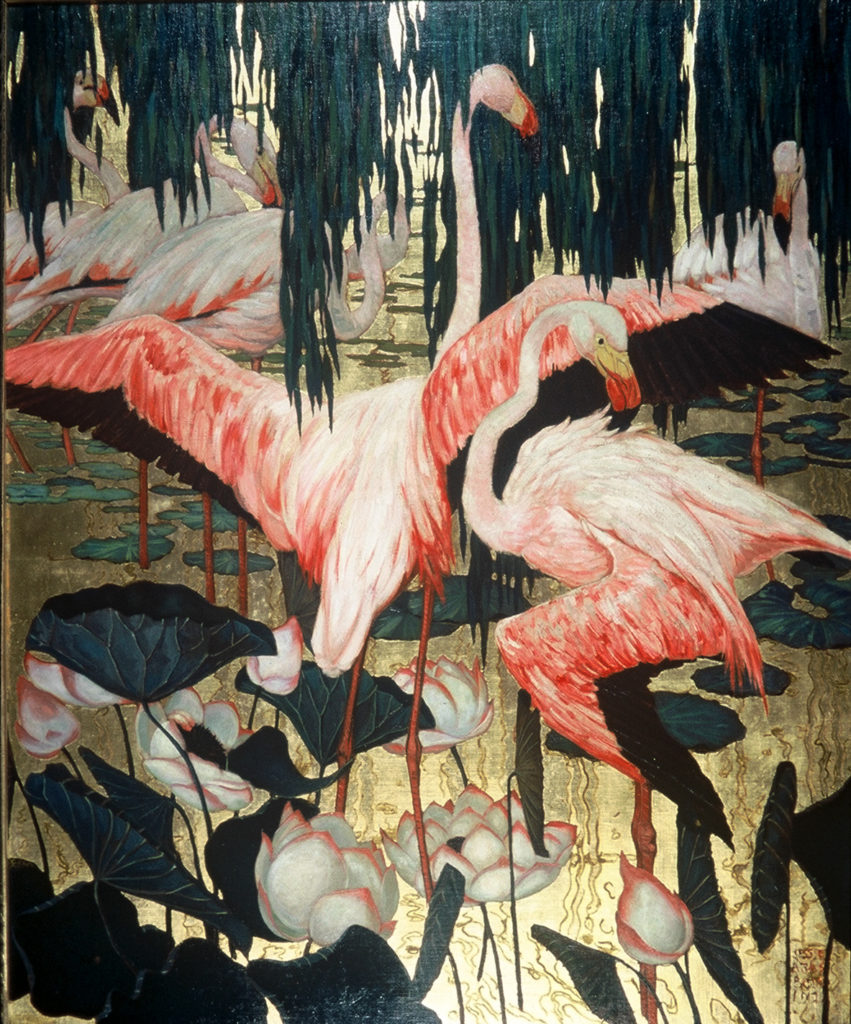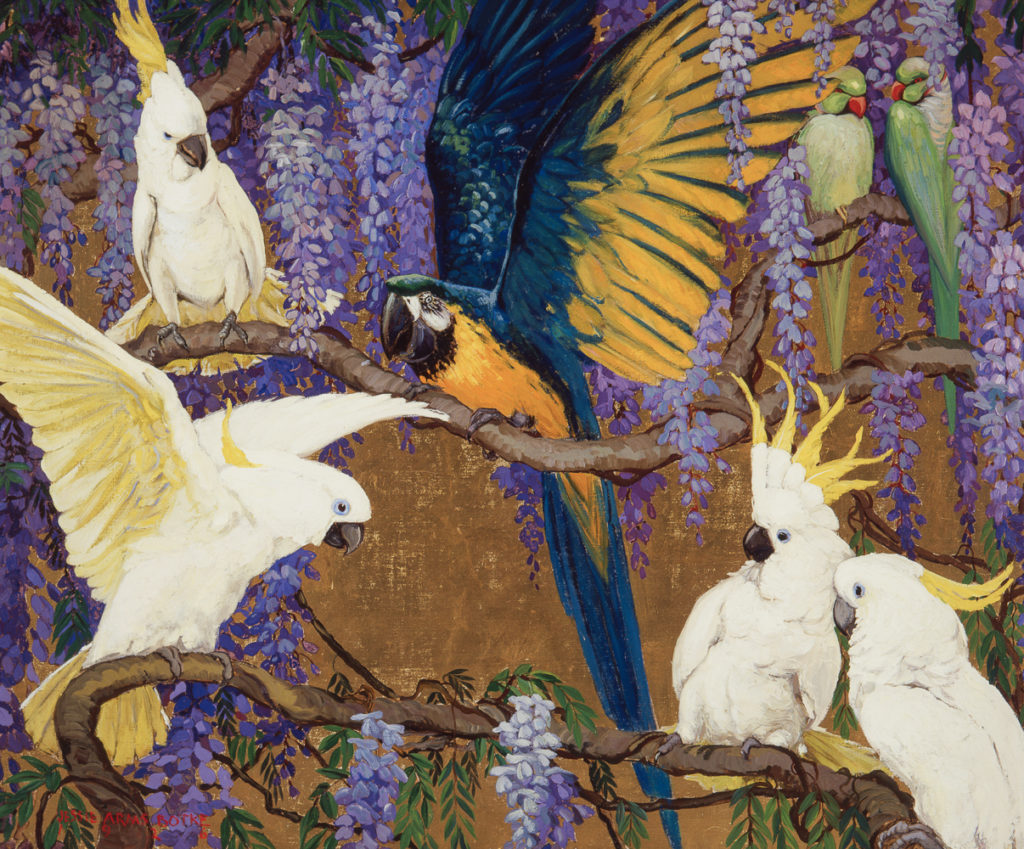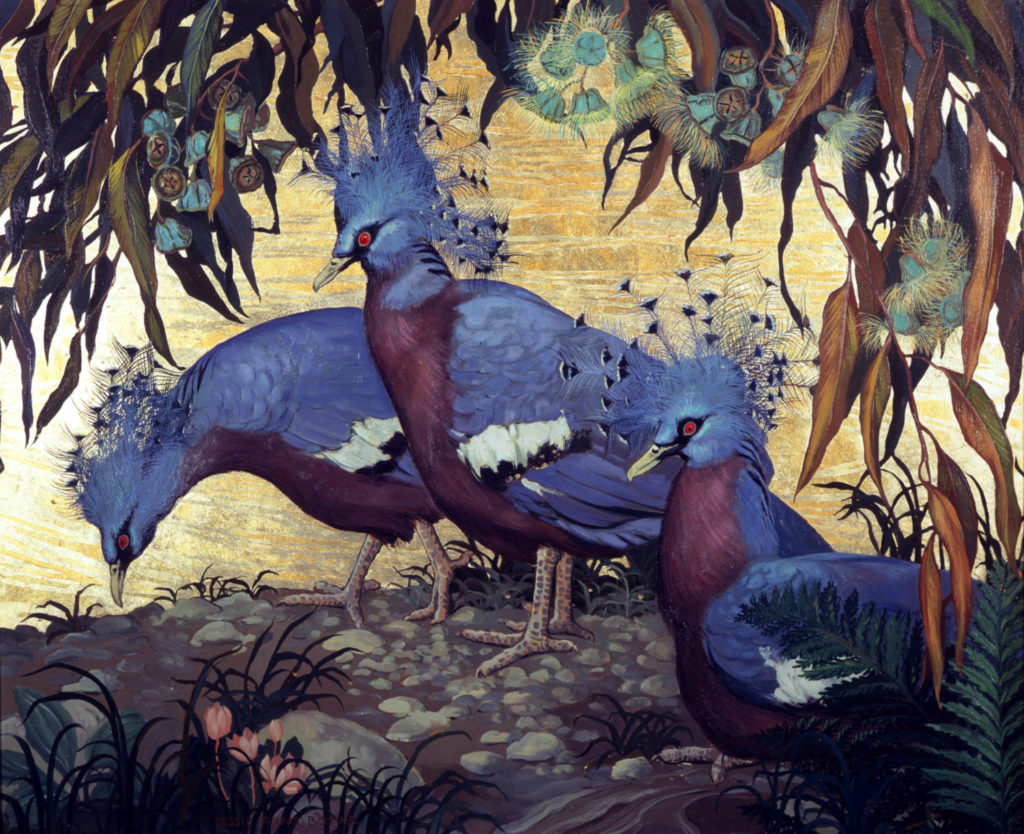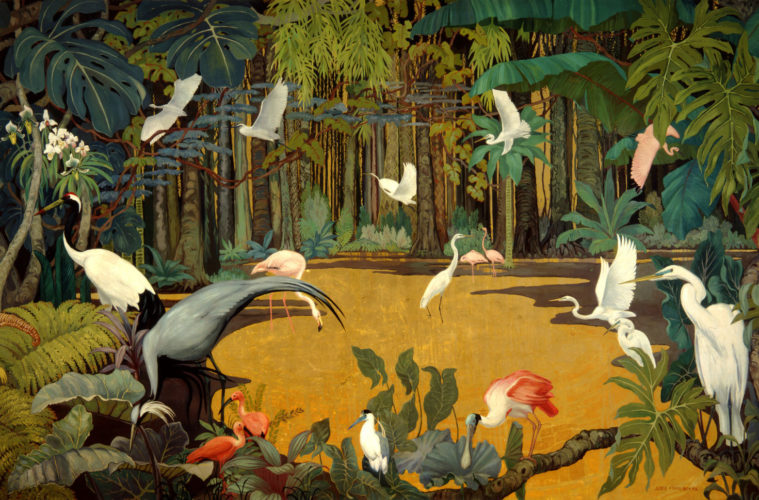A magnificent 26-foot-wide mural adorns Laguna Art Museum’s exhibition of work by 20th-century artist Jesse Arms Botke. Her “Untitled Mural From The East Wall,” an oil on canvas with gold leaf, depicts a tropical paradise with pink flamingos, pelicans, herons and other birds, set among colorful foliage and flowers.
While viewing this iconic mural, Jean Stern, Director Emeritus, The Irvine Museum, related a heartwarming story about its creation and rescue. Botke (1883-1971) painted the mural in 1955 for the Oaks Hotel in Ojai. As it was installed in the hotel lobby, the mural suffered damage over the years due to occasional contact from people walking by.
In 1996, the hotel removed the mural and it was soon after donated to the Irvine Museum. After several months of detailed restoration, including re-installing the gold leaf, the mural was delivered to the museum. But as the nascent venue was then located on the 12th floor of an office building, the rolled-up mural was too big for the elevator, and it was temporarily installed at a UC Irvine venue. Soon after, the museum was relocated to the ground floor, and the mural was subsequently displayed there in three exhibitions where it became a major attraction, especially with children who often counted the number of birds within it.

Jesse Arms Botke: Flamingos, oil on board (The Irvine Museum Collection at UCI)
As a centerpiece in Laguna Art Museum’s current Botke exhibition, the untitled mural reveals what Stern refers to as the intent to dazzle the eye with line, form, detail, color, elegance and patterned and stylized forms.
More than two dozen Botke paintings displayed in the museum’s front gallery complement and enhance the mural. These include “Crowned Pigeons,” a detailed illustration of three large blue birds, proudly wearing feathery crowns. “Macaw & Cockatoos” features four white cockatoos surrounding a bold macaw as it spreads its wings. “Untitled Flamingos” is a riot of the pink birds spreading their wings, as flowers around them reflect their colors. “Cockatoos and Easter Lily Vine” includes exceptional details of bird wings and feathers along with flowers and foliage that seem to burst from the canvas. And the majestic “White Necked Cranes” in dark gray provides a counterpoint to the colorful paintings. Other birds in her work and in this show include peacocks, ducks, swans, geese, pheasants and toucans.
Visiting the Laguna Art Museum gallery, viewing so many finely wrought paintings of birds, can feel like a quick trip to the Everglades. Spend enough time there and you can almost hear the tropical birds cooing, crowing and making a racket.

Jessie Arms Botke: Macaw & Cockatoos, 1926. Oil on board, 25 x 30 in. (The Irvine Museum Collection at the University of California, Irvine. Photo: Hiroshi Clark)
Laguna Art Museum has installed numerous exhibitions of work by 20th-century artists. But “A Fanciful World: Jesse Arms Botke,” with paintings from the same period, differs from previous museum shows, which have included important pieces by impressionist artists. While those California painters used broad brush strokes and pure, bright colors to illustrate the bucolic SoCal landscape, many Botke pieces are inspired by the Art Deco style, which is characterized by precise, linear and dynamic images and often by exotic subjects. Her primarily representational work is also influenced by medieval tapestries with their intricate designs and abundance of flowers, foliage and trees, and by the centuries old method of applying gold and silver leaf to paintings to add luster and shimmer.
Botke, born in Chicago in 1883, began attending art classes at the School of the Art Institute of Chicago in 1897, and later attended the Art Institute full-time. While painting in her spare time, she worked as a book illustrator and interior decorator for major firms in Chicago and New York City, often designing tapestries and creating murals for hotels, universities and private homes. She also traveled to Europe where she met the Spanish impressionist Joaquin Sorolla.
As Botke evolved as an artist, she became recognized for her remarkable ability to accurately depict birds of all kinds. And after moving to California with her husband Cornelis Botke, she took advantage of the warm climate here, observing and photographing birds at the San Diego Zoo and on her own ranch in Santa Paula. (Several birds that she illustrated are now extinct.)

Jesse Arms Botke: Crowned Pigeons, oil on board (The Irvine Museum Collection at UCI)
Throughout the 1930s, 40s and 50s, when Botke was able to paint full-time, her scintillating art pieces were shown across this country in galleries and museums, particularly in New York, Chicago and Los Angeles. In fact, she was blazing her own artistic path. Inspired by her early professional work, by the various art movements burgeoning around her, by her travels and especially by her love of nature, she produced a unique body of work.
Illustrators throughout the ages have accurately drawn and painted birds, most notably John James Audubon. Yet Jesse Arms Botke’s paintings—which also depict birds faithfully—eclipse their work with her aesthetic perceptions and flair.
A Fanciful World: Jessie Arms Botke on view at the Laguna Art Museum, Laguna Beach through January 16; lagunaartmuseum.org.
Advertising disclosure: We may receive compensation for some of the links in our stories. Thank you for supporting LA Weekly and our advertisers.

